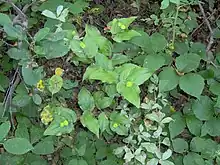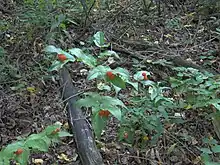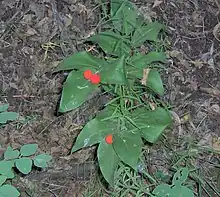Prosartes trachycarpa
Prosartes trachycarpa, the roughfruit fairybells,[2] rough-fruited fairybells or rough-fruited mandarin, is a North American species of plants in the lily family.[3][4] The species is widespread, known from British Columbia to Ontario and south to Arizona and New Mexico.[4][1] One isolated population was reported from Isle Royale in Lake Superior.[4]
| Roughfruit fairybells | |
|---|---|
 | |
| Scientific classification | |
| Kingdom: | Plantae |
| Clade: | Tracheophytes |
| Clade: | Angiosperms |
| Clade: | Monocots |
| Order: | Liliales |
| Family: | Liliaceae |
| Genus: | Prosartes |
| Species: | P. trachycarpa |
| Binomial name | |
| Prosartes trachycarpa | |
| Synonyms[1] | |
| |
Description
This herbaceous perennial is 30 centimeters (12 in) to 80 centimeters (31 in) in height. The stems are only sparingly branched and have a softly fuzzy texture when young and become smooth or nearly so with age. The leaves are alternate and are about 4 centimeters (1.6 in) to 12 centimeters (4.7 in) long.[4]
The flowers are delicate and hang down from the stem tips, each flower has four pedals. The berry is larger than a Saskatoon, pincherry or chokecherry, about the size of a grocery store cherry or small grape. The rough-fruited fairybell can be found in the same locale as other native fruits such as Saskatoons and chokecherries.[5][6][7] Berries begin yellow, then orange and when fully ripe are red, often with all three colors on the same raceme.[8] Typically 2—3 berries grow on each stem tip. The surface of the fruit feels fuzzy and velvety.[4] The berries are edible, but bland.[9]
The species is listed amongst plants found in the Prince Albert National Park and Riding Mountain National Park and are considered a common range plant of northern Saskatchewan.[10][11]
Uses
The berries have historically been eaten by Blackfeet Native Americans.[12]


References
- POWO (2023). "Prosartes trachycarpa S.Watson". Plants of the World Online. Royal Botanic Gardens, Kew. Retrieved 27 May 2023.
- USDA, NRCS (n.d.). "Prosartes trachycarpa". The PLANTS Database (plants.usda.gov). Greensboro, North Carolina: National Plant Data Team. Retrieved 14 October 2015.
- Utech, F. H., Z. K. Shinwari, and S. Kawano. 1995. Biosystematic studies in Disporum (Liliaceae-Asparagoideae-Polygonateae). VI. Recognition of the North American section Prosartes as an autonomous genus. Memoirs of the Faculty of Science, Kyoto University, Series Biology 16: 1–41.
- Utech, Frederick H. (5 November 2020). "Prosartes trachycarpa - FNA". Flora of North America. Retrieved 27 May 2023.
- Vance, F.R.; Jowsey, J.R.; McLean, J.S. (1977), Wildflowers Across the Prairies, Saskatoon, SK: Western Producer Books, p. 141, ISBN 0-919306-74-8
- Vance, F R; J.R. Rowsey; J.S Maclean; F.A. Switzer (1999), Wildflowers across the prairies With a new section on Grasses, sedges and rushes, Vancouver, British Columbia: Western Producer Prairie Books, p. 25, ISBN 1-55054-703-8
- Wilkinson, Kathleen (1999), Wildflowers of Alberta A Guide to Common Wildflowers and Other Herbaceous Plants, Edmonton Alberta: Lone Pine Publishing and University of Alberta, p. 19, ISBN 0-88864-298-9
- Barr, Claude A. (1983). Jewels of the plains : wild flowers of the Great Plains grasslands and hills. Minneapolis: University of Minnesota Press. p. 67. ISBN 0-8166-1127-0.
- Stark, Eileen (30 July 2018). "Pacific Northwest Native Plant Profile: Fairy bells (Prosartes spp.)". Real Gardens Grow Natives. Retrieved 29 August 2023.
- Innvista, Prince Albert National Park, archived from the original on 2008-07-06, retrieved 2008-08-03
- common range plants of northern Saskatchewan (PDF), retrieved 2008-08-03
- Reiner, Ralph E. (1969). Introducing the Flowering Beauty of Glacier National Park and the Majestic High Rockies. Glacier Park, Inc. p. 118.
 Media related to Prosartes trachycarpa at Wikimedia Commons
Media related to Prosartes trachycarpa at Wikimedia Commons
